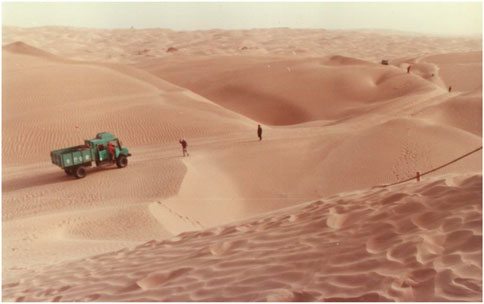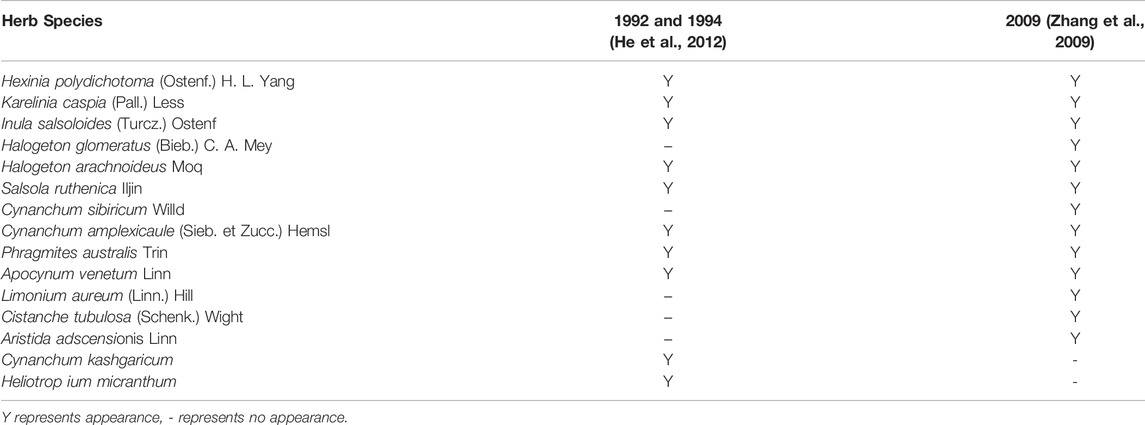- 1National Engineering Technology Research Center for Desert-Oasis Ecological Construction, XinJiang Institute of Ecology and Geography, CAS, Urumqi, China
- 2University of Chinese Academy of Sciences, Beijing, China
The longest artificial highway shelterbelt flowing across the Taklamakan desert was conducted in 2005. To ensure the sustainable development of the highway and shelterbelts, scholars have carried out a large number of studies on the shelterbelt since 1991. This review is based on a 30-year monitoring program from 1991 to 2021. We find that, with the increase of shelterbelt age, some ecological and economic benefits gradually appear, such as saving transportation cost, promoting economic development in Southern Xinjiang, improving the sandy soil and microenvironment, and increasing the biodiversity. In the meanwhile, some adverse phenomena also exist, such as high maintenance costs, decrease in water tables because of irrigation, threats of the protected species, pollution from pumping oil wells, and the potential damage from highway burying as sand dunes move forward. In view of these problems, some suggestions are as follows. First, the science-policy sections of both the UNFCCC and the UNCCD should pay special attention to providing research-based guidance for the international cooperation and coordination. Second, China government should provide the necessary funding to establish the 27th China desert observation and research station to ensure long-term monitoring and slow down the pace of construction on the desert highway to allow time to develop strategies that minimize the impact on wild animals. Third, it is necessary to apply solar photovoltaic power in well irrigation and sand industry development. Fourth, the sand-blocking belt of 10 m width and 10 m away from the outside of the upwind shelterbelt can be laid every five years in view of sand-buried roads. In short, the inter-agency collaboration and coordination are both essential to ensuring the success of sustainable development and management of the Taklamakan Desert man-made ecosystem.
Introduction
The rapid development of oil and gas resources in the Taklamakan Desert of Southern Xinjiang, China, throughout the 1980s prompted the construction of the first and longest (522 km) highway across the shifting sand desert in 1995. The intended purpose of the highway was to provide efficient transportation of resources and materials to oilfield bases and local communities. The Taklamakan Desert Highway is also a strategic communication line for oil and gas resource exploration and plays a vital role in the socioeconomic development and stability of Southern Xinjiang. At the beginning of its operation, the desert highway was frequently buried by wind hazards and sand movement. In order to ensure the safe operation of the desert highway, the Taklamakan Desert man-made ecosystem was created. The man-made ecosystem includes the Taklamakan Desert Highway Shelterbelt as well as the Taklamakan Desert Botanic Garden (TDBG) (38.97°N, 83.66°E), which were both established in 2005 within the hinterland of the Taklamakan Desert (Figure 1).
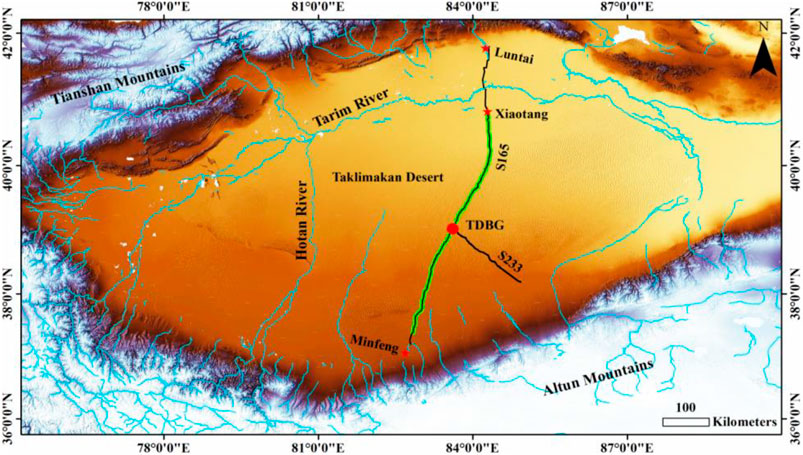
FIGURE 1. Map of the Taklamakan Desert Highway and the Taklamakan Desert man-made ecosystem. The black line represents the desert highway, which crosses the Taklamakan Desert from Luntai County to Minfeng County. The green lines from Xiaotang to Minfeng on both sides of the highway represent the man-made shelterbelt. The red solid point represents the Taklamakan Desert Botanic Garden\.
Scientists have carried out a series of studies on the function of windbreaks provided by the Taklamakan Desert Highway Shelterbelt and the effects it may have on sand fixation (Xu and Hu, 1998; Wang et al., 1999; Dong et al., 2006), microclimate benefits (Wang et al., 2003), changes in sandy soil properties (Zhou and Xu, 2004; Zhou et al., 2006; Jin et al., 2008; Zhang et al., 2008; Li et al., 2015; Wang et al., 2018), plant growth changes (Yan et al., 2007; Li et al., 2008; Li et al., 2017), and biodiversity (Zhang et al., 2011; Xu et al., 2013). Despite its benefits, there have been few sustained studies on the Taklamakan Desert man-made ecosystem. In this review, we explore the effects of the man-made shelterbelts after 15 years of protecting the world’s longest desert highway built on a shifting sand desert. Our evaluation and review are both based on a 30-year monitoring and ground observation from 1991 to 2021. Here, we briefly explore the background of the Taklamakan Desert man-made ecosystem and highlight the key findings from our evaluation and review.
Background of the Taklamakan Desert Man-Made Ecosystem
The Taklamakan Desert, the largest mobile sand desert in China, is called the “Sea of Death” due to the lack of living organisms in the extreme environment, which is characterized by rare rainfall and strong evapotranspiration (Lei et al., 2008; Li et al., 2015). When the discovery of oil and gas in the Taklamakan Desert was made in the 1980s, it was a challenge to transport goods and materials within the desert. Initially, desert trucks were used; however, the high transport costs and timely travel times were not ideal. In fact, it took more than half a month to exit the desert (Figure 2) (Luo et al., 2008). Due to the need for more efficient transportation, the desert highway was constructed by PetroChina Tarim Oilfield Company via governmental support from 1991 to 1995 (Luo et al., 2008).
At the beginning of the highway’s existence, more than 70% of the vertical sand barrier and straw checkerboards did not function efficiently (Lei and Wang, 2003; Dong et al., 2004; Li et al., 2017) (Figure 3A) (Lei et al., 2008; Li et al., 2015), and then a 436-km Taklamakan Desert Highway Shelterbelt (TDHS) (Figure 3) (Yang et al., 2003) and the Taklamakan Desert Botanic Garden (TDBG) were constructed in 2005 to protect the desert highway and oilfield facilities from wind-sand disasters (Figure 3). Today, the shelterbelts are called the “Great Green Belts” throughout the Taklamakan Desert of China (Zhou et al., 2006; Li et al., 2015).

FIGURE 3. Comparison of the protecting effects of the shelterbelt for the Taklamakan Desert Highway and Taklamakan Desert Botanic Garden, the vertical sand barrier, and straw checkerboards in 1994 (A); the shelterbelt has been built in 2008 (B), before the Taklamakan Desert Botanic Garden has been established in 1995 (C) and after in 2006 (D).
Because of no effective precipitation and available freshwater resources and the low quality, saline groundwater, which typically contains solutes of 2.58–29.7 gL−1, respectively, can be used as the solo water resource for shelterbelt growth (Figure 4) (Li et al., 2012; Li et al., 2015). A total of 108 underground water wells are used for dripping irrigation for the shelterbelt plantation along the highway; 11 are pumped using solar energy, 11 are pumped using electricity, and 86 are pumped using diesel power (Yang et al., 2003; Luo et al., 2008).
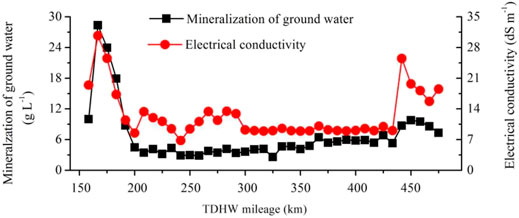
FIGURE 4. Spatial distributions of groundwater mineralization and electrical conductivity in the salt crust along the desert highway, reproduced from Li et al. (2012).
Findings and Problems
Saline Groundwater Table Dropped Slightly but There Is No Harm to the Plants
The mineralization of groundwater greatly affects soil salinity, especially for the topsoil or salt crust (Zhang et al., 2008; Li et al., 2012; Dou et al., 2015; Huang et al., 2015). We found electrical conductivity in soil crust changing with the mineralization of ground water (Figure 4). Salt was not only accumulated at the topsoil, but also leached to the underlying soils (130–280 cm) and ground water (410 cm) (Li et al., 2012.). While at the root zone (15–130 cm), soil salinity was no more than 0.5 dS m−1. This result indicated that saline irrigation not only leads to formation of soil salt crusts, but also leads to soil salts leaching to the ground water. Since the earliest shelterbelt planted in 1995, no salt toxicity to plants has been found (Li et al., 2015).
However, for groundwater level, there is a decreasing trend of no more than 0.1 m, which has been found from 2003 to 2009 (Figure 5). (Fan et al., 2008; Fan et al., 2017; Wei et al., 2017; Fan et al., 2020). Another study documented that the main influencing factors of groundwater level along the desert highway are natural factors, while human factors of water pumping do not form large changes (Zhou et al., 2016) which is mainly because there is no difference of water loss between soil evaporation and plant transpiration in desert areas (Liu et al., 2018). And a recent finding shows that a moderate irrigation interval of 4 weeks is suitable for plant growth and survival, which may also save water while meeting the water demands of the plants (Li et al., 2017). While, without long-term and continuous monitoring, there is uncertainty about changes in the water table and water quality in future.
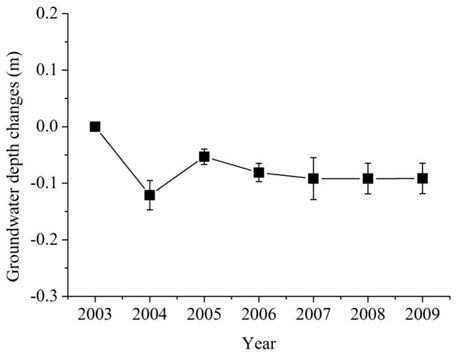
FIGURE 5. The groundwater dynamics along the highway (Fan et al., 2017), reproduced with data kindly provided by Dr. Fan Jinglong, Chinese Academy of Sciences.
Aeolian Sand Soil Quality Has Been Improved
Litter accumulation of man-made ecosystems (6–10 t hm−2 per year) and their decomposition (Zhang et al., 2017), as well as their complex interaction between plants and soil, not only accelerated the biogeochemical cycle of the desert (Zhang et al., 2012; Dong et al., 2020), but also significantly accelerated the aeolian sandy soil transformation (Li et al., 2015; Jin et al., 2017; Jin et al., 2018). The acceleration of these processes has resulted in an increase of SOC (Figure 6) and nutrient accumulation with the forest ages, the SOC content increased from 0.64 g kg−1–3.94 g kg−1 23 years later. Soil microbial biomass and diversity also increased significantly with the forest ages (Zhou and Xu. 2004; Jin et al., 2009; Jin et al., 2013, 2014). Additionally, the texture of the soil has also been improving (Figure 7) (Jia et al., 2015; Shen et al., 2015; Wang et al., 2018), there has been a significant increase of total soil aggregate stability (Wang et al., 2018). After 7 years of irrigation, coupled with nutrient elements from litter accumulation, the transformed soil under the shelterbelt has progressively been formed, as indicated by the increase of total soil particles and stability (Li et al., 2015). When compared with ordinary shifting sand soil, it is evident that the initial soil transformation under the shelterbelt has taken place (Figure 8).
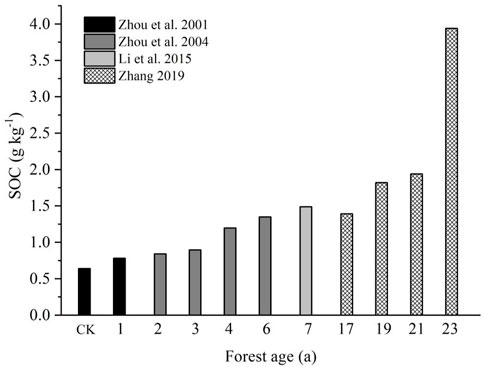
FIGURE 6. SOC content at different forest ages (Zhou and Xu. 2004; Zhou et al., 2006; Li et al., 2015; Zhang et al., 2017).
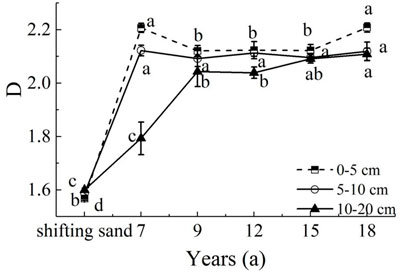
FIGURE 7. Changes of D of PSD in shelterbelt soil of different forest ages (Wang et al., 2018).
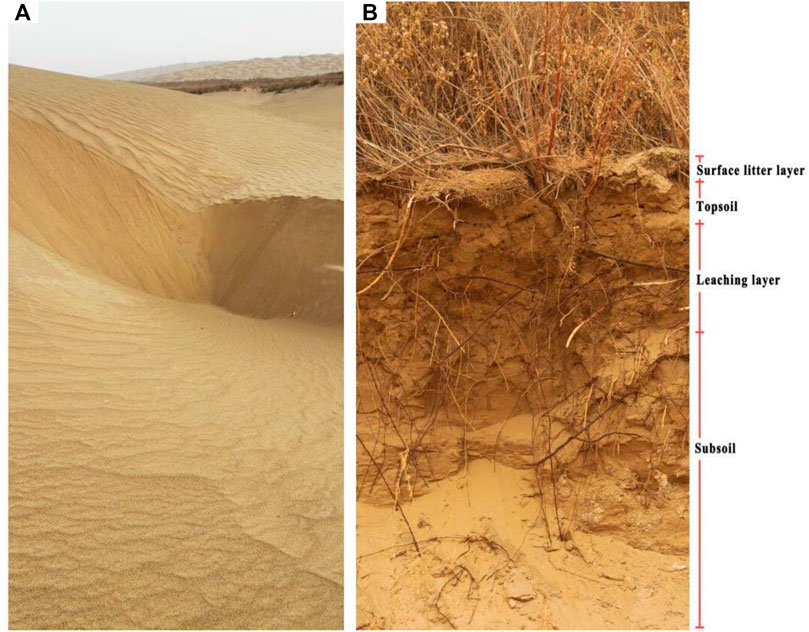
FIGURE 8. Stratification of soil of shifting sands before the shelterbelt has been built in 1990 (A) and that under the shelterbelt (B) in 2021.
Improving Microclimate
The Taklamakan Desert man-made ecosystem has greatly ensured the function of windbreak and sand-fixation efforts and improved local microclimate conditions. These not only improve the working conditions, but also enhance the livelihood of those local residents, especially in the oilfields within the hinterland of the Taklamakan Desert (Xu et al., 2006a; Luo et al., 2008). Since the highway shelterbelts effectively reduce air temperature and increase the air humidity (Wang et al., 2003; Wang et al., 2008; Yu et al., 2017), and the temperature has dropped an average of 0.66°C throughout the day and the humidity in sheltered areas increased an average of 4.2% when compared with the non-sheltered shifting sand surface, the surrounding environment of the shelterbelt has improved significantly, (Wang et al., 2008).
The Double-Edged Sword of Biodiversity
Studies on the survival (Figure 9) and growth (Figure 10) of introduced plants along desert highways have found that the growth of three well-surviving plants presented a difference in plant height in different forest ages (Figure 10) (Zhang et al., 2017; Zhang et al., 2017), the height for Tamarix ramosissima grew from 55 cm to 2.615 m in the ninth year, and the plant height for Haloxylon ammodendron and Calligonum aborescens also grew more than 1.2 and 1.7 m, respectively for seven years. While in some parts of TDHS, Haloxylon ammodendron grew well but Calligonum mongolicunl has been dead due to irregular or insufficient irrigation (Figure 9). Such phenomena documented that the different adaptability or adaptive strategies of the two species appeared in this area (Li et al., 2017).
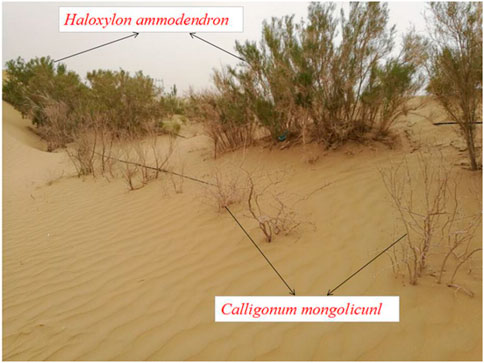
FIGURE 9. Growth status of Haloxylon ammodendron and Calligonum mongolicunl in parts of the Taklamakan Desert Highway shelterbelt (Li et al., 2017).
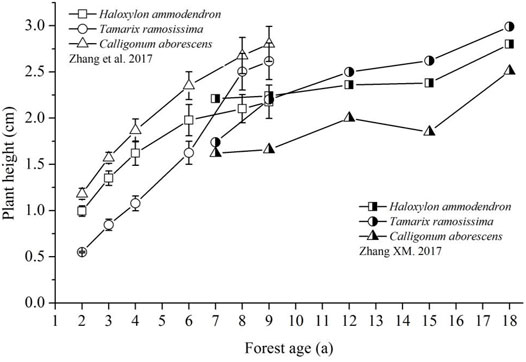
FIGURE 10. Plant growth dynamics along the highway, reproduced from Zhang et al. (2016) and Zhang et al. (2017).
Until 2009, a total of 13 species of herbaceous plants were found along the shelterbelt, among them, 10 were perennial herb species, and 3 were annual herb species. Phragmites australis and Phragmites staghorn were the dominant species in the shelterbelt sand break (Zhang et al., 2011), and continue to be the dominant plant coverage of the sand break to this date, as they have grown significantly in numbers since the shelterbelt was first established (Hu and Pan, 1996). Compared with the results of 1992 and 1994 (He et al., 2012), 5 more species of herbs appeared and two species of Cynanchum kashgaricum and Heliotrop were lost (Table 1). In the shifting sandy area surrounding the shelterbelt, only 10% of the sections are distributed with natural vegetation, while in the shelterbelt herbaceous plants account for 44% sections of the shelterbelt (He et al., 2012).
Additionally, the sand break shelters have attracted significantly more animals near the highway due to the man-made ecosystems. In the surrounding area, mammals including Lepus sinensis, Gerbillinae, and Vulpes corsac, as well as endemic birds such as Podoces biddulphi, Calandrella rufescens, and Passer ammodendri, can be found more frequently due to the man-made ecosystems (Luo et al., 2008; Xu et al., 2013).
While the highway construction generates noise, brings tourist waste, and forces the camels and other animals to migrate to resource-limited areas. As Yang et al. (2019) reported that over the past several years, because of the habitat fragmentation, excessive hunting, climate change, resource competition, genetic stochasticity, and crossbreeding, China’s wild camel population reduced to fewer than 600. China’s rush to build highways in the Xinjiang region puts its remaining wild camel population in grave danger (Yang et al., 2019).
Controlling the Sandstorm and Stabilizing Shifting Sands
The vertical plant shelterbelt sand break can significantly hinder the aeolian sand flow and reduce sand movement. The sand-fixing belt stabilizes the sand surface and controls sand encroachment, while the sand-blocking belt prevents the rapid movement of shifting sands into the shelterbelts (Wang, 2010). The influencing distance of the sand-fixing belt on the upwind is about 40 m, and that of the downwind is more than 80 m (Wang, 2010). The wind velocity attenuation rate among shelterbelts decreased down to 45% of that of shifting sand on average (Wang et al., 2008; Yu et al., 2017). Compared with 80 m outside the shelterbelt, the sand movement rate decreased by 93, 99, and 98%, respectively, at the three protection configurations (Wang, 2010). The shelterbelt on both sides of the desert highway can effectively block the sand flow and greatly reduce the impacts of sand flow to the highway (Li et al., 2017). In addition, the soil salt crust greatly enhances the stability of the sand surface and improves its ability to resist wind erosion as a result of the saline water irrigation in the area (Li et al., 2006; Zhang et al., 2009; Wang et al., 2018).
Sand Dune Migration
Although shelterbelts can prevent and control sand dust along the highway, there is still a phenomenon of sediment deposit moving forward highway despite the presence of the shelterbelt. Based on Wang‘s research in 2010, a prediction model is used to predict the trend of sand accumulation in the protection system through investigation and research, where S represents the amount of sand accumulation, X represents the height of the existing dune, A represents the length of the lee slope of the existing dune, L represents the distance of the existing sand burying, X1 represents the part of the increased protection system, and L1 and L2 represent the advance distance of the sand burying before the sand burying (Wang 2010).
Under the condition of constant protection height (Figure 11A) from the prediction model, the advancing velocity of the dune is 2.22 m a−1, which is similar to the advancing velocity of 2.35 m a−1 and those were the observations from the sand ridge line in 2008–2009 (Wang 2010).
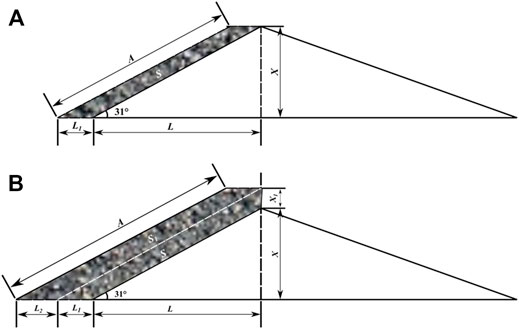
FIGURE 11. Schematic diagram of sand dune migration velocity prediction model under the shelterbelt system, reproduced with data kindly provided by Dr. Wang Haifeng, Chinese Academy of Sciences.
Under the condition of shelterbelt height increased (Figure 11B), it is predicted that the velocity of the dune is 2.16 m a−1, which is slightly larger than the 1.98 m of the observed sand ridge move advanced from 2008 to 2009 (Wang 2010). In this case, the sand dune ridge line migrates about 2 m each year, whether the shelterbelt height is increased or not, and the sand dune burying the highway will occur many years later if no measures are taken to clean up the sand in some parts (Wang 2010).
Economic Inputs and Outputs
Irrigation Maintenance Cost
The diesel-powered water pumps used for wells along the highway utilize a great deal of diesel, which cost upward of 100,000 RMB Yuan per well per year, and pollute the air in the surrounding environment. Each year along the desert highway, 1,200 t of diesel fuel is burned and 5,000 t CO2 is emitted into the atmosphere (He et al., 2012). The annual cost of solar photovoltaic power generation is about 95,000 RMB Yuan, which is only slightly lower than that of diesel power. While this is currently true, with the continuous development and improvement of solar energy products, the cost in solar photovoltaic power generation will become cheaper (He et al., 2012). The total cost of maintaining the entire artificial ecosystem is 20 million RMB Yuan per year.
Raising Income in Southern Xinjiang
In the 1990s, the total industrial and agricultural output value of Minfeng County located on the southern edge of the Taklamakan Desert, was only 40 million RMB Yuan, while the local farmers’ annual income was as low as 750 RMB Yuan per year. Since the operation of the desert highway, Minfeng has opened as the “East Gate” of Hotan Prefecture and has connected the social markets inside and outside Xinjiang. Meanwhile, the desert highway has brought the Minfeng people closer to developed areas where they can participate in the market economy. The highway has been so monumental that in the year 2000, the per capita income of the county was 4,000 RMB Yuan (Luo et al., 2008). Then, in 2018, the GDP of Minfeng was recorded to be 1.169 billion RMB Yuan with a per capita annual income of 30,400 RMB Yuan. It is evident that the desert highway and the sand break have played an essential role in the reduction of poverty and the improvement of local residents’ livelihoods, and have promoted economic development in Southern Xinjiang (Barbier. 2010).
Carbon Fixation and Oxygen Release Benefits
The total value of carbon sequestration and oxygen release was 225.553 million RMB Yuan and 503.2 million RMB Yuan, respectively, while the total value of carbon sequestration and oxygen release was 728.753 million RMB Yuan. The carbon sequestration value was 9,013 RMB Yuan hm2− a−1, and the oxygen release value was 2,009 RMB Yuan hm2− a−1. The total carbon sequestration and nutrient release value was 29,122 RMB Yuan hm2− a−1; and after 15 years, the total carbon sequestration and nutrient release value of the sand break is 1.75 billion RMB Yuan (Gao et al., 2015).
Reduction of Transportation Costs
Before the construction of the desert highway, it was very expensive to hire a desert 4W Jeep. At the time, it cost more than 40 RMB Yuan km−1 to rent a desert truck that could carry 10 t of heavy freight. Since the construction of the highway, however, the rent cost of a heavy freight truck is only 4-5 RMB Yuan km−1, and it requires only 6–7 h to drive from one station to another rather than 6–7 days. Evidently, the highway has significantly lowered transportation costs (Zong, 1995; Gong et al., 2001). Until 1997, most of the mechanical sand control barriers had been damaged by strong wind and sand encroachment. Before the establishment of the sand break, 3 million RMB Yuan was spent each year on average to replant the straw checkerboards and rent bulldozers to clear the highway (Lei and wang, 2003; Lu et al., 2020).
Income From Sand Land-Related Development
In the hinterland of the Taklamakan Desert, a 240-ha of Cistanche deserticola plantation industrialization base has been built. The dehydrated produce of the medicinal herb is about 4,000–6,600 kg ha−1, and the income is 50,000–80,000 RMB Yuan ha−1 per year (Fan et al., 2020). If the entire sand break system is planted with C. deserticola, the annual income will be as high as 72 to 120 million RMB Yuan, and it was more than the cost for management and protection of the sand break, which was approximately 20 million RMB Yuan per year. However, up to now, no area of Cistanche has been increased because of serious theft by the farmers nearby.
Ecological–Economical Win–Win Goals
Ecology is the basis of human existence and the main resources of economic development. Ecosystem degradation is a major cause of poverty, and poverty further aggravates ecosystem degradation through a feedback known as the “poverty trap” that can prevent sustainable socioeconomic development in ecologically fragile areas (Cao et al., 2017). Therefore, the economic development should be based on the premise of ecological protection and pay great attention to the effect of ecological protection on economic development (Feng et al., 2019). From the perspective of the relationship between ecological and economic development, they are equal and unified and can influence each other. Ecology provides basic environment and resources for economic development, and conversely, economic development can also serve ecological protection (Cao et al., 2021). Rational utilization of ecological environment resources is conducive to sustainable economic growth. We need to strike a balance between ecological protection and economic development, exert to find a way of harmonious coexistence, and improve ecological and economic benefits. We should pay attention to the role of ecological protection in economic development and find the method of ecological sustainable development in economic development (Barbier 2010). Therefore, to achieve ecological-economic win-win goals, a conceptual model of ecological-economic benefits of the shelterbelt in the Taklamakan Desert is shown in Figure 12. First, the water cycle has been depicted to display that there has been no change in either groundwater level or quality with the introduction of saline irrigation. Second, the carbon cycle indicates that not only the shelterbelt exerts great effort on carbon fixation and oxygen emission(Gao et al., 2015), but also accelerates sandy soil transformation because of plant litter decomposition, microbial activity, and root system development(Li et al., 2015; Zhang et al., 2017). Third, the ecological-economic benefits reveal that the shelterbelt plays a great role to ensuring the safe operation of the highway, improving the microclimate, enrich species diversity, and increase economic benefits (Cao et al., 2017). It is suggested that the man-made shelterbelt paired with saline irrigation is of great significance to ecological restoration in extremely arid environments. The success of the plantation, which is equipped with native desert plants and cash crops in the shifting sand desert land areas, effectively decreased the damage caused by strong winds and shifting sands (Wang et al., 2020). The man-made ecosystem has also been found to effectively protect local natural resources (Zhang et al., 2011), such as desert herbal medicine, and set up new means of transportation to increase the income of farmers living in the desert (Fan et al., 2020). However, some adverse phenomena occur in the meanwhile, such as the tradeoffs between economic activity and ecological integrity. In other words, since the excessive pursuit of economy will certainly have a certain impact on ecology (Cao et al., 2021), it is necessary to carry out long-term monitoring on water–soil–air–biology along the desert highway shelterbelt to ensure its sustainable development and keep the balance between economy and ecology.
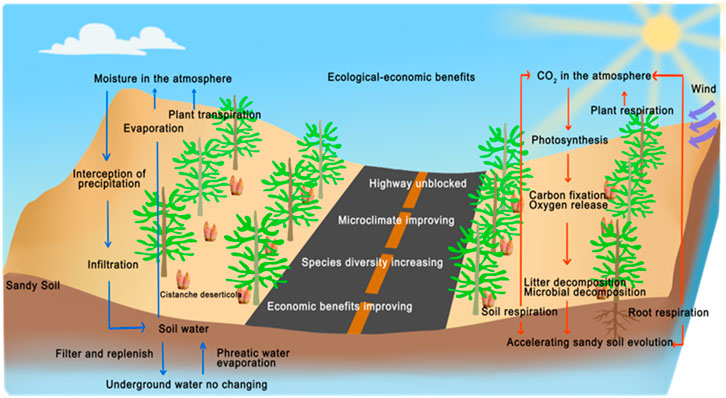
FIGURE 12. Conceptual diagram of sustainable development of the man-made ecosystem in the Taklamakan Desert.
Discussion and Recommendations
China is one of the most serious countries undergoing the desertification, and the artificial ecosystem model in this study is significant for transportation, economic development, and ecological construction in desert region. China’s successful experience in combating desertification has attracted world attention and some countries began to follow suit, which demonstrated that such model can also be used in Central Asia and African countries (Xing et al., 2018; Zhou et al., 2018).
Although the Chinese government has made remarkable contributions to desertification control over the past 40 years (Bryan et al., 2018), a total of 26 Chinese desert observation and research stations have been set up. However, it is necessary to form a long-term observation and research network system that integrates observation, scientific research, and demonstration, while meeting the various needs of ecological construction and regional economic construction in desert areas (Lu et al., 2020). The desert highway shelterbelt system is well-recognized amongst both local and central governments, as it successfully provides ecological services and social benefits.
Nevertheless, continuous and systematic monitoring is still rare, such as water table dropping, sand dunes moving forward, and sand-buried roads, causing pollution and carbon dioxide emissions from diesel-powered wells, high maintenance costs, and reduction in species diversity, and the decline in the population of wild camels (Yang et al., 2019). This means that the sustainable development of the desert highway shelterbelts cannot be predicted and their ecological service cannot be evaluated either. In particular, the global carbon neutrality in the desert ecosystem cannot be assessed. Though the technical model is being extended to other countries undergoing desertification and economic slowdown such as Mauritania, Nigeria, Ethiopia, Uzbekistan, and Kazakhstan (Xing et al., 2018; Zhou et al., 2018; Fenetahun et al., 2019; Fenetahun et al., 2020; Hare et al., 2020; Boraa et al., 2021), there has been little international cooperative research on the man-made ecosystem within the Taklamakan Desert. Some advanced ideas or concepts, such as the ecological and economic win-win development in the western desert region of the United States should be introduced.
Some suggestions are highlighted here to address these problems. First, it is suggested that the science-policy sections of both the United Nations Framework Convention on Climate Change (UNFCCC) and the United Nations Convention to Combat Desertification (UNCCD) lay special stress on the issues discussed in this study. Continuously providing research-based guidance will be most effective for the international cooperation and coordination between the affected countries to mitigate desertification, land degradation, and drought effects (Fu et al., 2020).
The man-made sand break is composed of desert shrub species, which are native varieties but do not meet the targets of carbon trading in the Intergovernmental Panel on Climate Change (IPCC). Broad-leaved trees are not suitable plants for arid desert areas since they are high water-consumption species, while shrub species are the dominant plants in the desert ecosystem because they are equipped with drought tolerance. Other than cash crops like C. deserticola, other ecological management and development initiatives are vigorously encouraged, such as the plantation of Lycium ruthenicum Murr, Cynomorium songaricum, and Hippophae rhamnoides Linn. The further processing of desert land produce and cash crops is also encouraged as well as desert eco-farm tourism, desert camping, sand skiing, and desert landscape exploration.
Second, it is highly recommended that the shelterbelt is given continuing monitor and support from both the Ministry of Sciences and Technology and the government of Xinjiang Uygur Autonomous Region, especially in future scientific studies and ground experiments. The research should be financed by governmental departments, not just by civil society organizations and enterprises. We proposed that the government provides the necessary funding to establish the 27th China desert observation and research station in the hinterland of the Taklamakan Desert, especially considering the progressing extreme climate conditions. In this case, the long-term groundwater monitoring should be strengthened, in order to understand the dynamics and hydrology of groundwater, and ultimately, its future development may be predicted. Also we can screen drought-resistant and salt-resistant species to reduce the irrigation amount and ensure the sound development of groundwater. It also reveals that selecting feasible and scientific methods of irrigation with saline water is particularly important.
Third, to protect the biodiversity and wild animals, such as the China’s wild camels, the Chinese government has established several nature reserves, but the species will need additional preservation efforts. China should slow the pace of construction on the Tarim Desert Highway to allow time to develop strategies that will effectively minimize the construction’s impact on camels (Yang et al., 2019). The government should also enforce existing hunting bans, implement scientific management, and improve public awareness of wildlife protection.
Fourth, in order to make up for the expensive maintenance costs required for the man-made ecosystem, and achieve China’s dual carbon goal and reduce CO2 emissions caused by fossil fuels, we should increase the use of solar energy and other clean energy (He et al., 2012). Southern Xinjiang, where the desert highway is located, has the most abundant solar energy resources of all regions in China. Therefore, it is necessary to make full use of solar energy resources and apply solar photovoltaic power in irrigation along the Taklamakan Desert man-made ecosystem, which inevitably lead to the C sequestration due to the C emissions reduction, compared with diesel fuel combustion for generating electricity. This can not only save fossil fuel, but also protect the environment from harmful emissions (Hosenuzzaman et al., 2015). This significant carbon emission reduction can save a value of 5 million RMB Yuan per year. It is a win-win for the ecology and the economy. Additionally, we should promote the development of photovoltaic industry in desert areas. Moreover, in view of the phenomenon of sand-buried roads caused by dune ridge moving forward in some sections of highway, in addition to regular removal measures, the sand-blocking belt of 10 m in width and 10 m away from the outside of upwind shelterbelt can be laid every five years. Only when such aspects are addressed, artificial shelterbelt construction and highway protection can receive a more promising and prosperous future in Taklamakan Desert.
In short, inter-agency collaboration and coordination are both essential to ensuring the success of sustainable development and management of the Taklamakan Desert man-made Ecosystem. With accelerating cooperation among governmental departments, enterprises, and scientific research institutions, it is possible to achieve both ecological service and economic growth. The synergy among economic development, social growth, and environmental protection is the guarantee of a harmonious coexistence between humans and nature. This review provides successful models that directly address desertification control and sand industry development, which can be promoted in African countries. Also, the same approach being used to stabilize sand dunes could be exported to those countries and regions undergoing desertification for reference in order to promote economic development and environmental improvement.
Author Contributions
Conceptualization: CL and JF. Data curation: MA and HW. Formal analysis: CL and JF. Funding acquisition: CL. Methodology: CL. Writing—original draft: CL. Writing—review and editing: CL and HW.
Funding
This work was supported by the Xinjiang National Key Research and Development Program (2019B00005 and 2021B03002-4), the Western Light” program of the Chinese Academy of Sciences (2021-XBQNXZ-002 and 2020-XBQNXZ-013), and the National Natural Science Foundation of China (31971731 and 41771121).
Conflict of Interest
The remaining authors declare that the research was conducted in the absence of any commercial or financial relationships that could be construed as a potential conflict of interest.
Publisher’s Note
All claims expressed in this article are solely those of the authors and do not necessarily represent those of their affiliated organizations, or those of the publisher, the editors, and the reviewers. Any product that may be evaluated in this article, or claim that may be made by its manufacturer, is not guaranteed or endorsed by the publisher.
References
Barbier, E. B. (2010). Poverty, Development, and Environment. Envir. Dev. Econ. 15, 635–660. doi:10.1017/s1355770x1000032x
Boraa, Z., Wang, Y. D., Xu, X. W., Angassa, A., and You, Y. (2021). Effects Comparison of Co-occurring Vachellia Tree Species on Understory Herbaceous Vegetation Biomass and Soil Nutrient: Case of Semi-arid savanna Grasslands in Southern Ethiopia. J. Arid Environ. 190, 104527. doi:10.1016/j.jaridenv.2021.104527
Bryan, B. A., Gao, L., Ye, Y., Sun, X., Connor, J. D., Crossman, N. D., et al. (2018). China's Response to a National Land-System Sustainability Emergency. Nature 559, 193–204. doi:10.1038/s41586-018-0280-2
Cao, S., Shang, D., Yue, H., and Ma, H. (2017). A Win-Win Strategy for Ecological Restoration and Biodiversity Conservation in Southern China. Environ. Res. Lett. 12, 044004. doi:10.1088/1748-9326/aa650c
Cao, S., Xia, C., Li, W., and Xian, J. (2021). Win-win Path for Ecological Restoration. Land Degrad. Dev. 32, 430–438. doi:10.1002/ldr.3739
Dong, Z., Li, H. L., and Hu, C. Y. (2006). Research on Cost Comparison and Wind-Break and Sang-Fixing Benefits of Different Sand-Fixing Measures of Highway in Desert Regions. Res. Soil Water Conservation 13 (2), 128–130. doi:10.1016/j.ecoleng.2008.09.013
Dong, Z., Chen, G., He, X., Han, Z., and Wang, X. (2004). Controlling Blown Sand along the Highway Crossing the Taklimakan Desert. J. Arid Environments 57 (3), 329–344. doi:10.1016/j.jaridenv.2002.02.001
Dong, Z., Li, C., Li, S., Lei, J., Zhao, Y., and Umut, H. (2020). Stoichiometric Features of C, N, and P in Soil and Litter of Tamarix Cones and Their Relationship with Environmental Factors in the Taklimakan Desert, China. J. Soils Sediments 20 (2), 690–704. doi:10.1007/s11368-019-02481-6
Dou, K. G., Wang, Y. D., and Lei, J. Q. (2015). Salt Distribution Characteristics of Taklimakan Desert Highway Shelterbelt under saline Water Drip-Irrigation. Arid Land Geogr. 38 (3), 576–584.
Fan, J. L., Li, B. W., and Xu, X. W. (2020). Technology Progress of Sand Industry Based on Desertification Control Engineering by Revegetation. Case Study on Cistanche Plantation 35 (6), 717–723.
Fan, J., Wei, Y. P., Wei, Y., Xu, X., and Yang, X. (2017). Effect of Drip Irrigation with saline Water on the Construction of Shelterbelts for Soil and Groundwater protection in the Hinterland of the Taklimakan Desert, China. Tecnol. Cienc. Agua 08 (2), 19–30. doi:10.24850/j-tyca-2017-02-02
Fan, J., Xu, X., Lei, J., Zhao, J., Li, S., Wang, H., et al. (20082008). The Temporal and Spatial Fluctuation of the Groundwater Level along the Tarim Desert Highway. Sci. Bull. 53, 53–62. doi:10.1007/s11434-008-6005-4
Fenetahun, Y., Xinwen, X., and Yongdong, W. (2019). An Evaluation of the Effect of Termites on Rangeland Degradation: The Case of Yabello, Southern Ethiopia. J. Resour. Ecol. 10 (5), 525–529. doi:10.5814/j.issn.1674-764x.2019.05.008
Fenetahun, Y., Yong-dong, W., You, Y., and Xinwen, X. (2020). Dynamics of Forage and Land Cover Changes in Teltele District of Borana Rangelands, Southern Ethiopia: Using Geospatial and Field Survey Data. BMC Ecol. 20, 55. doi:10.1186/s12898-020-00320-8
Feng, Q., Tian, Y., Yu, T., Yin, Z., and Cao, S. (2019). Combating Desertification through Economic Development in Northwestern China. Land Degrad. Dev. 30, 910–917. doi:10.1002/ldr.3277
Fu, B., Zhang, J., Wang, S., and Zhao, W. (2020). Classification-coordination-collaboration: a Systems Approach for Advancing Sustainable Development Goals. Natl. Sci. Rev. 7, 838–840. doi:10.1093/nsr/nwaa048
Gao, P., Li, C. J., and Tang, J. Y. (2015). The C, N Stoichiometry and Sequestration Capacity of Artificial Shelterbelt along the Taklimakan Desert Highway. Desert and Oasis Meteorology 9 (2), 63–68.
Gong, F. H., He, X. D., Peng, X. Y., Zheng, L. I., Han, Z. W., Duan, Z. H., et al. (2001). Comparison of Properties and Cost of Different Sand-Fixing System along Tarim Desert Highway. J. Desert Res. 21 (1), 45–49.
Han, W., Cao, L., Yimit, H., Xu, X. W., and Zhang, J. G. (2012). Optimization of the saline Groundwater Irrigation System along the Tarim Desert Highway Ecological Shelterbelt Project in China. Ecol. Eng. 40, 108–112. doi:10.1016/j.ecoleng.2011.12.009
Hare, M. L., Xu, X., Wang, Y., and Gedda, A. I. (2020). The Effects of Bush Control Methods on Encroaching Woody Plants in Terms of Die-Off and Survival in Borana Rangelands, Southern Ethiopia. Pastoralism 10, 16. doi:10.1186/s13570-020-00171-4
He, Z. K., Cui, Y. F., and Wang, C. (2012). Application of Photovoltaic Power Generation System in Irrigation of Desert Highway Shelterbelt. Pet. Petrochemical Energ. Saving 12, 45–48.
Hosenuzzaman, M., Rahim, N. A., Selvaraj, J., Hasanuzzaman, M., Malek, A. B. M. A., and Nahar, A. (2015). Global Prospects, Progress, Policies, and Environmental Impact of Solar Photovoltaic Power Generation. Renew. Sust. Energ. Rev. 41, 284–297. doi:10.1016/j.rser.2014.08.046
Hu, Y. K., and Pan, B. R. (1996). The Vegetations and its Features along the Taklimskan Desert Road Line. Arid Zone Res. 13 (4), 9–14.
Huang, Y., Wang, Y. D., and Zhao, Y. (2015). Spatiotemporal Distribution of Soil Moisture and Salinity in the Taklimakan Desert Highway Shelterbelt. Water 7 (8), 4343–4361. doi:10.3390/w7084343
Jia, M. M., Zhang, Z. L., and Lei, J. Q. (2015). Fractal Characteristics of Soil Particle Size Distribution in protection forest of Tarim Desert Highway. Arid Zone Res. 32 (4), 674–679.
Jin, Z. Z., Lei, J. Q., Li, S. Y., and Xu, X. W. (2017). Biochemical Intensity and Microbial Eco-Characterization of Soils Irrigated with saline Water from the Tarim Desert Highway Shelter-belt. Acta Ecologica Sinica 37 (12), 4091–4099. doi:10.5846/stxb201606131142
Jin, Z. Z., Lei, J. Q., Li, S. Y., and Xu, X. W. (2013). Variation Characteristics of Soil Microbial Activities in the Tarim Desert Highway Shelter Forests, Xinjiang of Northwast China. Ying Yong Sheng Tai Xue Bao 24 (9), 2464–2470.
Jin, Z. Z., Lei, J. Q., Xu, X. W., and Li, S. Y. (2014). Effect of the saline Water Irrigation on Soil Microbial Diversity and Fertility Quality in the Tarim Desert Highway Shelter forest Land. Acta Ecologica Sinica 34 (13), 3720–3827. doi:10.5846/stxb201211211644
Jin, Z. Z., Lei, J. Q., Xu, X. W., Li, S. Y., Zhao, S. F., Qiu, Y. Z., et al. (2008). Evaluation of Soil Fertility of the Shelter-forest Land along the Trim Desert Highway. Chin. Sci. Bull. 53 (Suppl. II), 125–136. doi:10.1007/s11434-008-6015-2
Jin, Z. Z., Lei, J. Q., and Xu, X. W. (2009). Microbial Diversities of Shelter -forest Soils in the Extreme Arid Area. Acta Ecologic Sinica 29 (8), 4549–4559. doi:10.3389/fmicb.2019.00069
Jin, Z. Z., Lei, J. Q., and Xu, X. W. (2009). Microbial Diversities of Shelter forest Soils in the Extreme Arid Area. Acta Ecologica Sinica 29 (8), 4549–4559. (in Chinese).
Jin, Z. Z., Wang, Y. D., and Lei, J. Q. (2018). Effects of the Rhizosphere on the Environmental Factors in the Tarim Desert Highway Shelterbelt. J. Desert Res. 38 (4), 808–814. doi:10.7522/j.issn.1000-694X.2017.00009
Lei, J., Li, S., Fan, D., Zhou, H., Gu, F., Qiu, Y., et al. (20082008). Classification and Regionalization of the Forming Environment of Windblown Sand Disasters along the Tarim Desert Highway. Sci. Bull. 53, 1–7. doi:10.1007/s11434-008-6023-2
Lei, J. Q., and Wang, X. Q. (2003). The Formation of the Blown Sand Disaster to the Tarim Desert Highway, Xinjiang, China. Arid Zone Res. 20 (1), 1–6.
Li, C. J., Lei, J. Q., and Xu, X. W. (2012). “Spatio-temporal Dynamics of Soil Salt under saline Irrigation in Taklimakan Desert Artificial Shelterbelt,” in The 2nd international Conference on Remote Sensing, Environment and Transportation Engineering, Nanjing, China, 1-3 June 2012 (IEEE), 2522–2526. doi:10.1109/rsete.2012.6260734
Li, C., Lei, J., Zhao, Y., Xu, X., and Li, S. (2015). Effect of saline Water Irrigation on Soil Development and Plant Growth in the Taklimakan Desert Highway Shelterbelt. Soil Tillage Res. 146, 99–107. doi:10.1016/j.still.2014.03.013
Li, C., Shi, X., Mohamad, O. A., Gao, J., Xu, X., and Xie, Y. (2017). Moderate Irrigation Intervals Facilitate Establishment of Two Desert Shrubs in the Taklimakan Desert Highway Shelterbelt in China. PLoS ONE 12 (7), e0180875. doi:10.1371/journal.pone.0180875
Li, T., Ji, X. L., and Xu, H. (2006). Study on Dynamic Growth of Forestation Trees on Talimu Desert Highway. J. Inner Mongolia For. Science& Tech. 3, 8–11.
Li, Y. G., Xu, X. W., and Li, S. Y. (2008). Analysis on the Cutting Benefit of Calligonum Arborescens in Shelterbelt along the Tarim Desert Highway. J. Arid Land Resour. Environ. 22 (8), 196–200.
Liu, R., Wang, Y., Li, C., Ma, J., and Li, Y. (2018). Partitioning Water Source and Sinking Process of a Groundwater-dependent Desert Plant Community. Plant Soil 430, 73–85. doi:10.1007/s11104-018-3714-6
Lu, Q., Lei, J. Q., and Li, X. S. (2020). China’s Combating Desertification: National Solutions and Global Paradigm. Proc. Chin. Acad. Sci. 35 (6), 656–665.
Luo, X. Z., Li, B. Z., and Ren, N. J. (2008). Let “Dead Sea” Become “Hope Sea”. China Pet. Petrochemical 19, 46–51.
Shen, F. Y., Wang, Y. D., and Li, S. Y. (2015). Study on Soil Aggregates of the Desert Highway Shelterbelt in Tarim. Arid Zone Res. 32 (5), 910–917.
Wang, F., Pan, X., Gerlein‐Safdi, C., Cao, X., Wang, S., Gu, L., et al. (2020). Vegetation Restoration in N Orthern China: A Contrasted Picture. Land Degrad. Dev. 31 (6), 669–676. doi:10.1002/ldr.3314
Wang, H. F. (2010). Research on Process of Wind-Blown Sand Remolding by protection forest on Tarim Desert Highway. China: Graduate University of Chinese Academy of Sciences.
Wang, H., Lei, J., Li, S., Fan, J., Li, Y., Sun, S., et al. (20082008). Effect of the Shelterbelt along the Tarim Desert Highway on Air Temperature and Humidity. Sci. Bull. 53, 41–52. SuppⅡ. doi:10.1007/s11434-008-6004-5
Wang, J., Sang, C. Q., and He, Q. (2003). Microclimate Analysis of Different Underlying Surfaces on Both Sides of Middle Taklimakan Desert Highway. J. Desert Res. 23 (5), 577–580.
Wang, X. M., Chen, G. T., and Han, Z. W. (1999). The Benefit of the Prevention System along the Desert Highway in Tarim Basin. J. Desert Res. 19 (2), 120–127.
Wang, Y., Zhao, Y., Li, S., Shen, F., Jia, M., Zhang, J., et al. (2018). Soil Aggregation Formation in Relation to Planting Time, Water Salinity, and Species in the Taklimakan Desert Highway Shelterbelt. J. Soils Sediments 18 (4), 1466–1477. doi:10.1007/s11368-017-1880-4
Wei, Y., Fan, J. L., Fan, J., Xu, X., and Lei, J. (2017). Water Table Response to a Pumping Test in the Hinterland Core Area of the Taklimakan Desert, China. Tecnol. Cienc. Agua 08 (2), 151–158. doi:10.24850/j-tyca-2017-02-14
Xing, Y. Y., Wang, Y. D., and You, Y. (2018). Dynamic Changes of the bush Encroachment in Low Altitude Area of Ethiopia. J. Resour. Ecol. 9 (03), 281–289.
Xu, F., Yang, W., Xu, W., Xia, C., Liao, H., and Blank, D. (2013). The Effects of the Taklimakan Desert Highway on Endemic Birds Podoces Biddulphi. Transportation Res. D: Transport Environ. 20, 12–14. doi:10.1016/j.trd.2013.01.003
Xu, H., Zhang, X. M., and Wang, Y. D. (2006a). Study on Water Consumption of Calligonum Arborescens litv.in Shelterbelts along the Tarim Desert Highway. Arid Zone Res. 23 (2), 216–222.
Xu, X. W., and Hu, Y. K. (1998). Analysis on protection Effect of Various Measures of Combating Drifting Sand on Tarim Desert Highway. Arid Zone Res. 15 (1), 21–26.
Xu, X. W., Hu, Y. K., and Pan, B. R. (1998). Analysis on protection Effect of Various Measures of Combating Drifting Sand on Tarim Desert Highway. Arid Zone Res. 15 (1), 21–26.
Xu, X. W., Li, B. W., and Wang, X. J. (2006b). Progress in Study on Irrigation Practice with saline Groundwater on Sandlands of Taklimakan Desert Hinterland. Chin. Sci. Bull. 51 (S upp.I), 161–166. doi:10.1007/s11434-006-8221-0
Yan, H. L., Zhang, X. M., and Xu, H. (2007). Response of Calligonum Arborescens Photosynthesis to Water Stress in Tarim Highway Shelterbelt. J. Desert Res. 27 (3), 460–465.
Yang, J., Fu, Q., Wang, D., Liu, X., and Xu, Q. (2019). China's Highways Threaten Wild Camels. Science 364, 1242. doi:10.1126/science.aay1264
Yang, N., Chen, S. B., and Qiu, J. J. (2003). Oilmen of Greening the “Dead Sea”. China PetroChem 10, 58–59.
Yu, X. X., Li, S. Y., and Wang, H. F. (2017). Aeolian-sand Flow Structure at Different Locations along Desert Highway Shelterbelt. Arid Zone Res. 34 (3), 21–26.
Zhang, D. D., Jin, Z. Z., and Xu, X. W. Study on Water Holding Capacity of Litters in Shelterbelt along the Tarim Desert Highway. Arid Zone Res. 2012, 29 (6), 1046–1053.
Zhang, J. G., Lei, J. Q., and Wang, Y. D. (2016). Survival and Growth of Three Afforestation Species under High saline Drip Irrigation in the Taklimakan Desert, China. Ecosphere 7 (5), e01285. doi:10.1002/ecs2.1285
Zhang, J. G., Xu, X. W., and Lei, J. Q. (2008). Effect of Drip-Irrigation with Salinity Water on Soil Environment of the Trim Desert Highway Shelterbelt. Trans. CSAE 24 (10), 34–39.
Zhang, J. G., Xu, X. W., and Lei, J. Q. (2009). Progress in the Researches of Sand Drift Disasters and Defense System along the Tarim Desert Highway. J. Northwest For. Univ. 24 (2), 50–54.
Zhang, J., Li, S.-y., Jin, Z.-z., and Lei, J.-q. (2011). Relationship between Species Diversity of Herbaceous Plants in the Shelterbelt and Environment Factors. Arid Zone Res. 28 (1), 118–125. doi:10.3724/sp.j.1148.2011.00118
Zhang, X.-M., Wang, Y.-D., Zhao, Y., Xu, X.-W., Lei, J.-Q., and Hill, R. L. (2017). Litter Decomposition and Nutrient Dynamics of Three Woody Halophytes in the Taklimakan Desert Highway Shelterbelt. Arid Land Res. Manag. 31 (3), 335–351. doi:10.1080/15324982.2017.1300613
Zhou, N., Wang, Y. D., and Lei, J. Q. (2018). Determination of the Status of Desertification in the Capital of mauritania and Development of a Strategy for Combating it. J. Resour. Ecol. 9 (03), 306–316. doi:10.5814/j.issn.1674-764x.2018.03.011
Zhou, P., Wang, Z., Zhang, J., Yang, Z., and Li, X. (2016). Study on the Hydrochemical Characteristics of Groundwater along the Taklimakan Desert Highway. Environ. Earth Sci. 75, 1378. doi:10.1007/s12665-016-6204-2
Zhou, Z. B., and Xu, X. W. (2004). Distribution Characteristics of Soil Enzymes of Talimu Desert Highway Shelter-forest and Their Relations with Soil Organic Matter. J. Soil Water Conservation 18 (5), 10–14.
Zhou, Z. B., Xu, X. W., and Lei, J. Q. (2006). Salt Balance and Movement of Tarim Desert Highway Shelterbelt Irrigated by saline Water. Arid Land Geogr. 29 (4), 470–475.
Keywords: taklamakan desert, man-made ecosystem, ecological benefits, economic benefits, sustainable development
Citation: Li C, Abulimiti M, Fan J and Wang H (2022) Ecologic Service, Economic Benefits, and Sustainability of the Man-Made Ecosystem in the Taklamakan Desert. Front. Environ. Sci. 10:813932. doi: 10.3389/fenvs.2022.813932
Received: 12 November 2021; Accepted: 28 February 2022;
Published: 23 March 2022.
Edited by:
Colin Tucker, United States Forest Service (USDA), United StatesCopyright © 2022 Li, Abulimiti, Fan and Wang. This is an open-access article distributed under the terms of the Creative Commons Attribution License (CC BY). The use, distribution or reproduction in other forums is permitted, provided the original author(s) and the copyright owner(s) are credited and that the original publication in this journal is cited, in accordance with accepted academic practice. No use, distribution or reproduction is permitted which does not comply with these terms.
*Correspondence: Jinglong Fan, ZmFuamxAbXMueGpiLmFjLmNu; Haifeng Wang, d2FuZ2hmQG1zLnhqYi5hYy5jbg==
 Congjuan Li
Congjuan Li Madinai Abulimiti1,2
Madinai Abulimiti1,2 Jinglong Fan
Jinglong Fan Haifeng Wang
Haifeng Wang